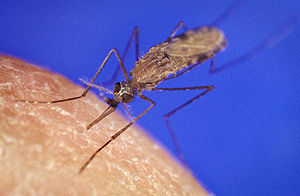Findings present potential strategy to control spread of malaria.
Tinkering with male mosquitoes so that they cannot produce sperm is a promising way to control the spread of the malaria-carrying insects in the wild.
Researchers had been concerned that female Anopheles gambiae mosquitoes might not be fooled into mating with the spermless males, but lab tests show that they are just as attracted to sterile males as to normal ones1.
Releasing such males into the wild offers a way to control malaria that does not rely on insecticides, which many species are increasingly developing resistance to.
“Any strategy that targets sperm is safe,” says Flaminia Catteruccia, a molecular entomologis at Imperial College London, UK, and lead author of the study1.
Pest control
The creation of sterile males is a strategy that has long been used to control insect pests, such as the Mediterranean fruitfly, or medfly, in countries including the United States. But researchers have struggled to apply the technique to mosquitoes. Sterility is traditionally induced by irradiating males, but in the mosquito’s case this affects fitness and ability to complete with untreated males for mates.
Moreover, there was a question mark over how the females would respond to the males because some insects are not fooled by spermless males. In the fruitfly Drosophila melanogaster, for instance, it is the presence of sperm after mating that stops females from remating and stimulates them to lay eggs.
“It is critical that the males behave normally,” says Catteruccia, “but nothing was known about how mosquitoes reproduce.”
Catteruccia and her team created 96 spermless male mosquitoes to test how the deficiency would affect female mating behaviour.
They used the technique of RNA interference (RNAi), injecting mosquito embryos with fragments of RNA that disrupted a crucial gene involved in the development of the testes, preventing males from producing sperm. This method of sterilization did not affect any other physiological function.
“Spermless males behave exactly like those with sperm,” Catteruccia says. “We saw no difference in their ability to compete.”
In addition, mating with sterile males did not affect female egg-laying, nor did it stimulate females to mate a second time. Some 74% of females that mated with spermless males produced eggs, laying an average of 58. By contrast, 83% of females mated with males with sperm produced eggs, and averaged 49 eggs.
“It is quite remarkable that females don’t use sperm as a measure of mating success,” says Catteruccia. She says more work is needed to figure out how the females know that mating has been successful, but suggests that the presence of seminal fluid could be one clue.
“This is a crucial scientific demonstration and a huge step forward,” comments Elena Levashina, who studies malaria carrying mosquitoes at the Institute of Molecular and Cellular Biology in Strasbourg, part of the French National Centre for Scientific Research (CNRS).









